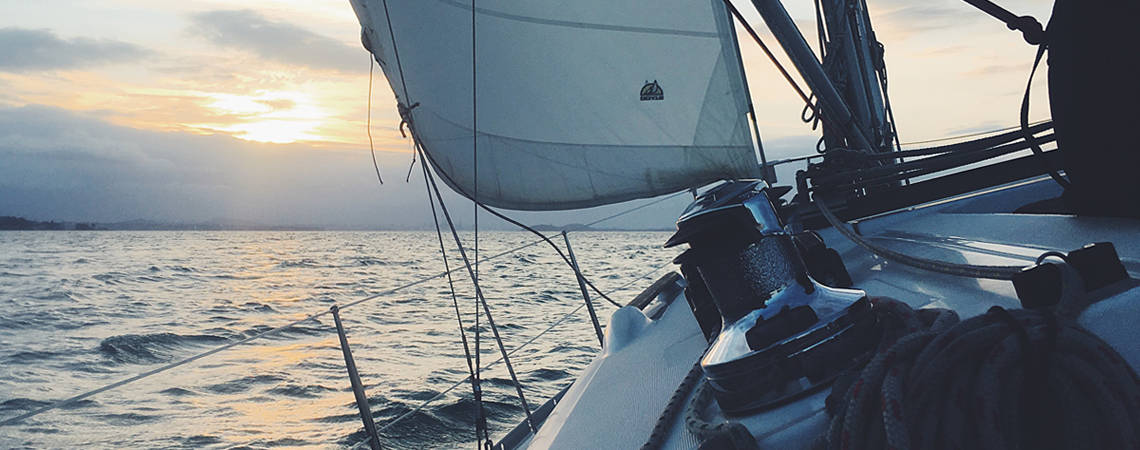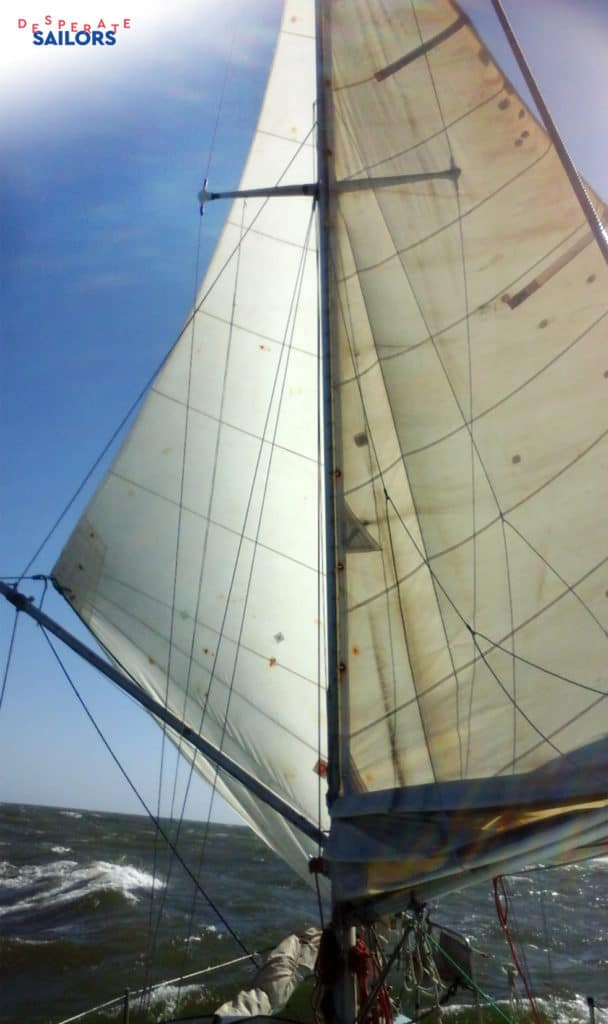Once you start learning how to sail, you need to add sailing terms and phrases to your vocabulary.
Your sailing instructor will surely speak sailing lingo, and you’ll get some proverbs from him too along with all the “mandatory” nautical terms. He’ll be giving sailing commands to you, and once you are a skipper, you will give sailing commands to other crew members.
You must know sailing terms in order to survive in the sailing world. Otherwise, you will not be able to speak clearly into a VHF or to officials or friends or anyone in the sailing community.
Nautical Terms vs Land Lubber Words
Forget your land lubber words. Let’s name things properly.
Some words only replace the normal words, serving the romantic image of seafaring. For instance, there is no “rope” on a boat; they are all “lines.” However, it’s not a crime to say “rope.”
Some sailing terms are general, while others exist to make your speech crystal clear and effective, such as “starboard” (the right side of the boat) and “port” (the left side of the boat). Your arms are left and right, but boat sides are port and starboard.
Others serve to be heard clearly via VHF, like “Mayday” or “Man overboard”, and we pray you’ll never need to use these two. “Do you understand?” shall be “Do you read me?” then you do not say “I understand” but it is “Loud and clear”.
The sailing terms are all useful and important to know when you are embarking on an adventure at sea. So, let’s get started on extending your sailing vocabulary with the minimum amount of sailing terms and phrases for beginners. These are terms you’ll want to know right away.
Ropes and Lines
All ropes on a sailboat are called lines. There are mooring lines, those holding your boat in a dock, there are safety lines, anchor lines, and there are lines you can use to dry your laundry. Well, any rope is a line.
However, some important lines have their own names. They are still lines, but specific ones.
Halyard
This one is the line used to lift stuff on top.
Halyard starts from the deck level or from the cockpit, sometimes jammed in the jammers in the modern yachts or secured on the clit at the bottom of the mast; then it goes all the way on top of the mast and the other end is secured to the top of your sail.
So, a halyard is used to set sail, and the sail is dropped once the halyard is released. Logically we conclude the length of a halyard is longer than two time the height of the mast.
There are several halyards going through the top of your mast.
Some are spare ones, and you can use them for multiple purposes.
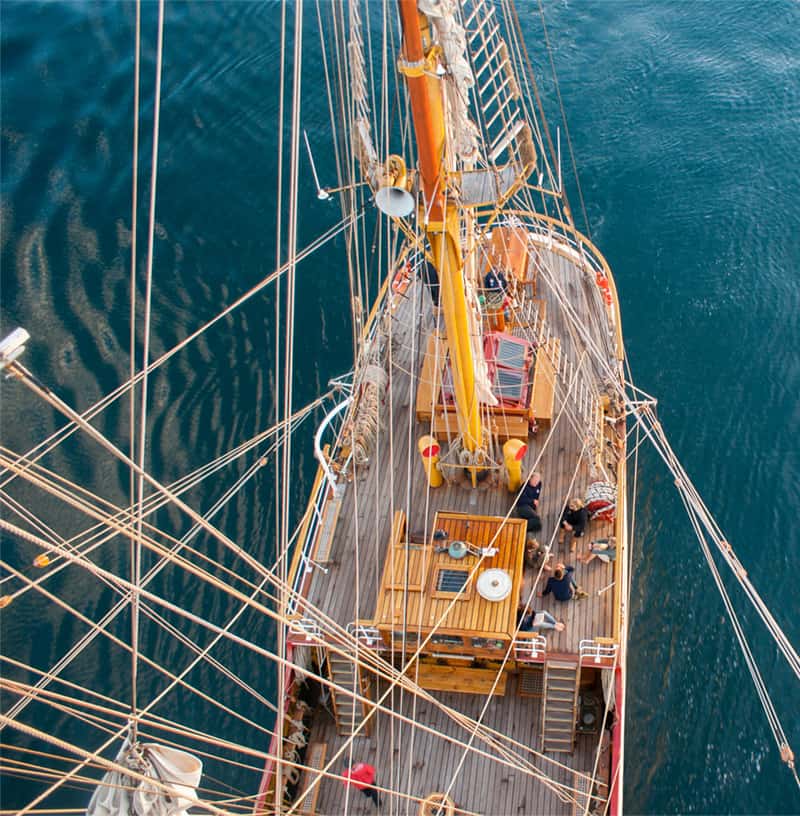
Sheet
This line is attached (secured) to the moving end of your sail. You adjust the sail to the wind by adjusting the sheet. The latter is sometimes called trimming the sail.
A modern bermuda sloop rig has three sheets. One is for the mainsail, and it is called the mainsheet, and two others connect to the free end of the front sail, which is the jib, and they are called jib sheets. You can choose a sheet to use depending on where the wind comes from.
On my sailboat, which is a cutter built in 1979, there are six sheets. Two hold the mainsail (which is a little inconvenient but okay), and two hold each jib while the cutter rig suggests two jibs.
Reefing Lines
Those are the ropes that are used to reef the main (sail).
Reefing
Stands for decreasing the sail area. Once the weather gets rough you reef the sail. For a regular sailboat there are two reefing lines for the main sail; one decreases the sail area, and the other decreases it even more. To decrease the area of a jib you furl it, if there is a furling installed, or you change the jib for a smaller one in the otherwise case.
Shrouds
The standing rig holds the mast, and shrouds are the lines going from the top of the mast to the sides of the boat, keeping the mast from falling aside.
Shrouds are usually metal wires, and there are a few of them holding the mast.
Stay
The lines holding the mast are usually metal wires, and apart from shrouds supporting the sides, those going to the bow and to the aft are called stays.
The one in front is the “forestay”, and it goes from the top of the mast to the bow.
The aft stays are called “backstays”, and there are usually two of them.
Anchor Line
Most people still call it a chain, but it can also be called an anchor line. It is certainly a line and rarely a chain for a small boat, dinghy, or your secondary anchor.
When you stop a running line (one that moves along, like a halyard or a sheet) from moving, like in a jammer or on a cleat or a winch, you “secure the line.”
Parts Of a Boat and Directions
They are numerous, but we mention the most important. We suppose there’s no need to explain what a mast, anchor, keel, cockpit, or cabin is, but below are some terms that may be less familiar.
Boom
The mainsail’s lower edge is fixed to the horizontal pole extending from the mast. This is called the boom.
The mainsheet holds the boom to adjust the main. You need to always be aware of where the boom is, as it can hit your head with brutal force.
The moving metal part that allows the boom to move while being attached to the mast is called a gooseneck. It is usually made of a very thick and strong alloy.
Aft
Refers to the back area of a ship. The direction is referred to as abaft.
Bow
The “nose”, the very front of a ship.
Stern
The farthest back part of a ship, where your rudder and carving are.
Whereas the aft points to anything within a boat, like an aft-cabin, but the stern is a particular part of the boat.
Astern points outside of a boat.
When you park, you would say you park stern-in, not aft-in.
Starboard
Means RIGHT. Precisely it’s a right side of any boat. Not your right hand side, as this might change depending which direction you face, but always the boat’s.
To simplify, starboard is the right when you look at the bow and where the green navigation light is. If you face astern it doesn’t change although your view and side changes.
Now you might understand better why “right” and “left” are not used at sea. Best part? You only have to know and remember one of them, as you will then know the other by default.
Also starboard describes both, direction (e.g. boom has moved to the starboard, to the right) and an actual right board of the boat. Like, a welcome flag when entering another country, you raise on the starboard shroud.
Also there is starboard-side word in use as well.
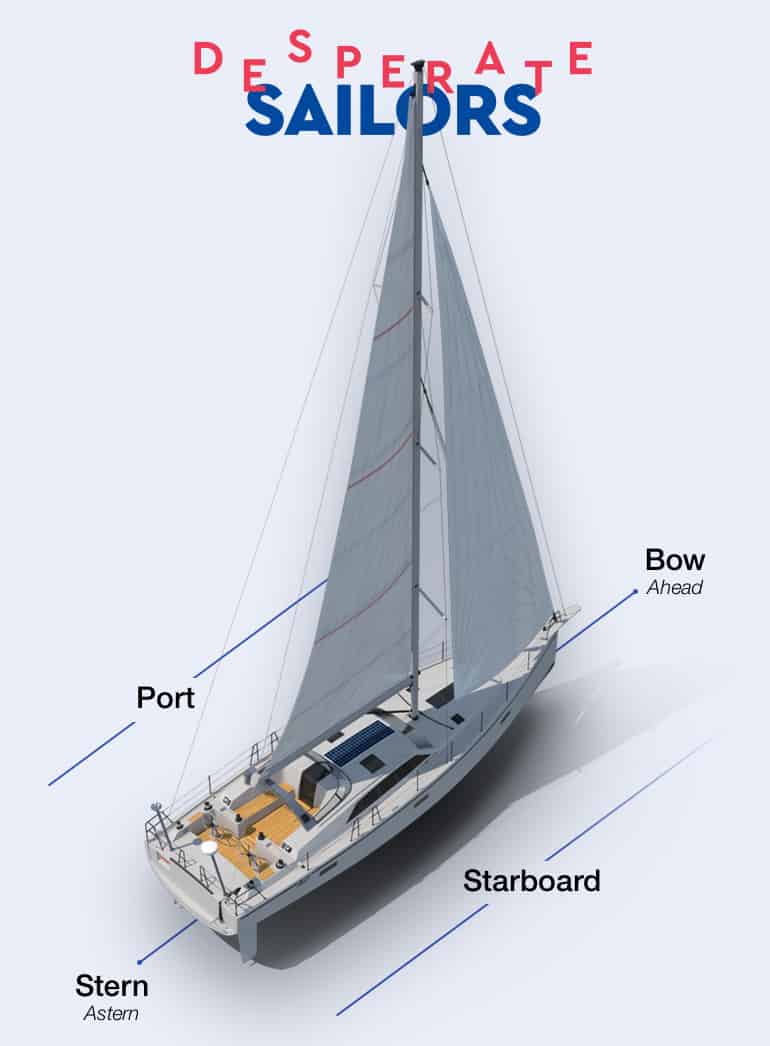
Port
Means LEFT. It’s a left side of any boat. Not your left hand side, but always the boat’s.
Port is the left when you look at the bow where the red navigation light is.
Also, there is port-side word (e.g. boom has moved port-side which is equal to boom has moved port).
Beam
The beam is the widest part of the boat. It’s somewhere in the middle between an aft and a bow.
Historically, the beam is the widest timber frame attached to the keel, the rib of a boat, and also may be used to refer to the maximum width of the boat hull.
The direction of your boat 90 degrees to her course is called abeam.
Rudder
This is a piece at the stern which makes your boat steer.
Do not confuse it with the wheel or tiller; the rudder is the underwater piece that is controlled by a wheel or a tiller.
Tiller
This is a long stick at the aft which you use to control the rudder when there is no wheel on the boat, the replacement of the wheel.
Older boats have a tiller instead of a wheel, and smaller boats and dinghies have tillers. There are pros and cons for both a wheel and a tiller.
TIP
Once you have a tiller on your boat, consider a tiller-extension, which is a very cool piece of equipment that is also relatively cheap, or DIY.
What Is Reach in Sailing Terms
Reach
Reach is the position of your boat in relation to the wind.
For example, if your boat is making its way and the wind comes from abeam, more or less 90 degrees, then that shall mean you are going beam reach.
Close reach is when the wind comes from abow, but not straight against the bow, a little to starboard either a little to port. In this case, you say that you go close to the wind. If you head too close to the wind, then the boat shall not move unless she is a motorboat.
How close to the wind can sailboats go? It depends on the rig and the hull design, and also the keel shape, but she’ll most likely go 35-45 degrees to the wind.
Broad reach is when the wind comes from astern, but not directly into the stern.
Dead run is the reach when the wind comes straight into the stern. In this case, you can say that you go “downwind.”
The fastest and most stable course is the beam reach. The close reach is also very stable yet slower, producing the most apparent wind in the cockpit.
Apparent Wind
Apparent wind is a physical sum of real wind and the wind produced by the movement of the boat.
Going dead run produces the weakest apparent wind, but the boat is most unstable and harder to steer.
Watch your boom in this position. Well, you watch it anyway, but on the “dead run,” the boom is likely to go to the other side very fast, making a strong deadly impact to a head if there is any on the way, and giving a big load on the gooseneck.
When you go dead run and the sails (main and jib) are on the opposite sides, such positioning of the sails is called butterfly, and you are “butterflying.”
Wind and Maneuvers
Windward
This is the side into which the wind blows, where you feel it. In other words the side which “accepts” the wind.
You know there are Windward Islands in the Caribbean? Because the trade-wind blows from east to west, the Windward Islands are on the east of the Caribbean sea.
Leeward
Leeward is the opposite of windward.
If you hide from a wind behind the wall, that would mean you hide from the leeward side of the wall.
Leeway
Leeway is the drift movement of the boat created by the wind.
Like, if you are going beam reach or close reach, your boat shall move in the desired direction, but also a little bit drifting in the direction of the wind. This is leeway. A keel basically prevents a boat from moving all the way leeway.
Tack
Tacking means changing the direction in relation to the wind in a way that the wind appears from the other side of a boat, and while changing it, your bow for a moment points against the wind.
When you go close reach because you wished to go against the wind but you cannot, then you tack a lot, left-right, left-right, etc.
If you go port tack, the wind hits from port (where the red navigational light is, left side if you face the bow), the sails are on the starboard then.
If you go starboard tack, the wind comes from starboard (where the green navigational light is, the right side if you face the bow), the sails are on the port then.
Gybe
Once you change your course in a way that the wind appears from the other side of a boat but your stern for a moment points to the wind, then you make a gybe.
Honestly, I only heard the term when taking a sailing course. Tacking is used far more often instead.
Heave to
Imagine the jib and its sheets are in the position opposite to their normal position relatively to the wind. Like, you go starboard tack then change to port tack, or vice versa, but you do not move jib sheets. The jib shall “stick” to the mast. This is heave to. In this position the boat stops, and she shall be drifting very slowly, because the keel shall resist drifting at its best. The wind shall be beam reach.
The heaving to is used, for example, to stop the boat at sea once you need a pause or a lunch. Also, during the man overboard rescue mission, including but not limited to. This is a very useful skill and the heave to, as you see, is relatively simple to perform.
And I’m unsure a heave to may work for the self-tacking rig, yet this one is a rare rig. Learn the heave to and you’ll never regret.
Other Sailing Terms and Phrases
Heading (as a noun), or to head (as a verb)
This is where you go. When you head north, you are going in the northern direction.
You head home, means you are going home. Or you head San Francisco, that shall mean San Francisco is where your bow points to.
Bearing
This is a directional term that refers to the horizontal angle between one object and another (relative bearing), or between it and the true north (absolute bearing). The angle is observed from either the North or South toward the East or West. It give a reading smaller than 90° (e.g. N60°E).
This is the equivalent of azimuth.
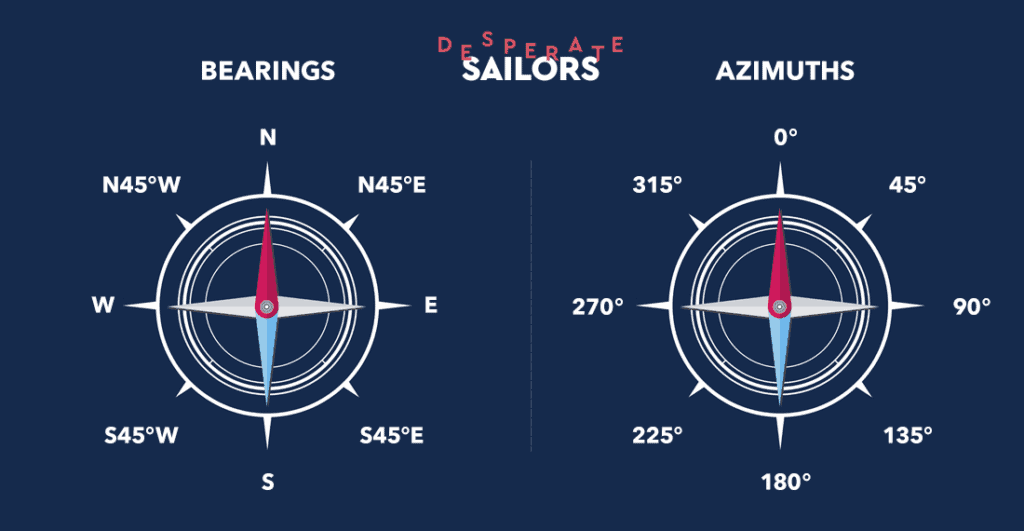
Bilge
Bilge is the lowest part of the inside of a boat. If water comes into your boat then you shall see water in the bilge, because all water goes down to the lowest part. The bilge pump is located in the bilge for a reason.
However, a bilge is not a spot, but more likely an area along the keel and in the middle of the boat, not necessarily in the middle between the bow and the stern, but in the middle from her sides, along the center-line.
Center-line is the symmetry line or the reflection symmetry, if you wish.
Berth
A berth is a slip in a port where you park your boat. Also, a place where you sleep, a bed.
Chandler Shop
A chandler shop is a marine shop.
Nautical Mile
It’s 1852 meters, a little longer than a common mile. Just in case…
Galley
A galley is a kitchen on a boat.
Seacock
A seacock is an intentional hole in a hull, with a valve or a tube connected to it.
For example, one is used to take in outboard water for cooling the engine, and another one is used to throw away the contents of your toilet. Yet another one gets your bilge pump working. Etc.
Jib and Jigger
Jigger is a jargon name for the mizzen sail, like on a ketch, or yawl, or schooner, which is on the mizzenmast (the second mast of a two-masted sailboat). When you go jib and jigger, it translates in that you have the main sail down, the jib is up, and the mizzen sail is up. That is done for stability in harder winds or out of your laziness in case you just have no wish to speed.
All Hands
This one is way useful and funny too, it may also fit for a normal life use. “All hands” is literally all people on the boat without exceptions at all. Like, you may enable all hands while the Man overboard situation.
Sailing Terms and Phrases – Bottom Line
There are a whole lot more sailing terms and phrases, as the lingo has been developed for centuries. They keep the tradition and add to the romantic image of seafaring. Everything on a boat and related to boating has an interesting name.
Pleasure boating nowadays accepts normal words too, so people can better understand each other when beginners are being welcomed into the sailing community.
But if you want to speak like a sailor, this list should give you some guidance through the jungle of the maritime vocabulary. After all, you can hardly skip knowing these sailing terms and phrases, you’d better believe it.
Good luck, Captain!
